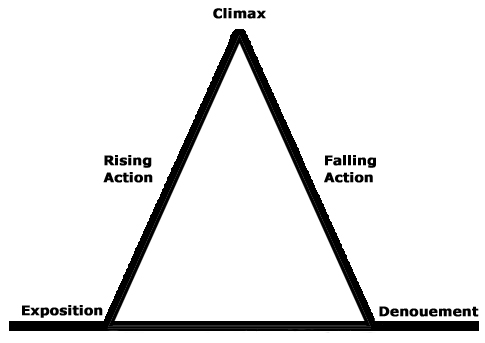1. The three-act story structure
 |
| The Freytag Pyramid |
The first act of a story is when they have the call to action and overcome the first "boss," to use video game jargon. Remember how in Mario Bros. games, you have to beat the boss in the small, mid-level castle before you can beat the boss at the end of the level? Defeating the first boss is the end of the first act. The second act happens when the character(s) realize(s) they have won the battle but are actually fighting a war. That act ends when the protagonist learns what they need to learn to be ultimately victorious, though they may or may not realize they learned it. The third act is the exciting end stuff, the final battle(s), when things work toward a resolution. I suppose that every act should have its own Freytag Pyramid.
Example: For the first Harry Potter book, the first act spans the time from the beginning until they defeat the troll. The second act takes over from there and ends when they realize that Hagrid slipped up and gave away the secret to getting past Fluffy. The third act is the rest of the book (I love that sequence, by the way, where they have to get past all those obstacles. One of my favorite parts of the entire series).
2. All climaxes should cascade together (when using multiple plots)
Novels don't have just one storyline. Besides the main one (destroying the ring), there are smaller plots, particular to each character (trying not to be destroyed by the ring, protecting a friend, finding and working with the Ents). These are where we experience character development, so they are just as important, if not more important, than the main plot. Each subplot should have its own climax, and that climax needs to coincide with the main one. We need to realize that Frodo is not going to become evil at the same time we see him destroy the ring. That not only brings all the tension into one massive fireball, but it feels more right for your reader. Plus, what are you going to do when all your subplots are already dead before the end?
Let me add that some subplots can end early. Their climax should coincide with a climax or major turning point in the main plot. Just don't kill all your subplots.
3. Fight scenes should have a lot of emotion and should not be blow by blow
 |
| Westley: Fighting because he wants to get to Buttercup. Inigo: Fighting because he wants practice, it's his job, and he is having fun. (I suspect that last one applies to Westley, too) |
Why are the characters fighting? Keep that in mind and in your readers' minds. Fights can also be used as a problem-solving exercise, something that makes your character think and learn something about themselves, their opponent, or their situation.
4. A nonhuman race needs to be human enough that we can relate to them.
Something that has stuck with me since I read some Nietzsche was the idea that I cannot learn anything unless I already know something about it. There has to be common ground for me to build on. If you try to describe "red" when I have never experienced color, I will not learn "red" no matter how hard you try. The same thing goes for writing a nonhuman race. As a reader, I will not understand them unless there is a base of similarity of experience. You have to describe them using comparisons I know and understand. Thus, Superman looks like a human even though he is from another planet. If he were an undescribeable monster, he would lose his superhero appeal.
Along with that, nonhuman species need to have more than one defining characteristic. They need dynamic personalities. No dog is exactly the same as the next dog, and no human is exactly like the next human. Give your species values, motives, customs, and any other detail you feel they need if they are going to be believable. Don't shortchange them just because they aren't human.
5. Government should have a face. What personal freedoms are allowed?
Aside from taxes, most of us see the government in our lives when they tell you what is and is not legal. An image comes to mind, whether that be a person, a flag, or a building. Both of these elements are needed if you are constructing a government that you want mentioned in your story. It provides a roundness to the world you are creating. No need to make a government, though, if you aren't going to use it at all.
That's it for today. Now I'm going to spoil myself and do some reading.

No comments:
Post a Comment